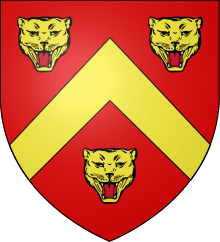George Parker, 4th Earl of Macclesfield
George Parker, 4th Earl of Macclesfield PC (24 February 1755 – 20 March 1842), styled Viscount Parker between 1764 and 1795, was a British peer and politician who sat in the House of Commons between 1777 and 1795.
The Earl of Macclesfield PC | |
|---|---|
 Arms of Parker, Earls of Macclesfield: Gules, a chevron between three leopard's faces or[1] | |
| Captain of the Yeomen of the Guard | |
| In office 1804 – 15 November 1830 | |
| Monarch | |
| Prime Minister | |
| Preceded by | The Lord Pelham |
| Succeeded by | The Marquess of Clanricarde |
| Personal details | |
| Born | 24 February 1755 |
| Died | 20 March 1842 (aged 87) |
| Nationality | British |
| Spouse(s) | Mary Frances Drake
( m. 1780; died 1823) |
Background
Macclesfield was the son of Thomas Parker, 3rd Earl of Macclesfield, and Mary, daughter of Sir William Heathcote, 1st Baronet.[2]
Political career
Macclesfield was returned to Parliament for Woodstock in 1777, a seat he held until 1784, and later represented Minehead between 1790 and 1795. In 1791 he was sworn of the Privy Council and appointed Comptroller of the Household, which he remained until 1797. In 1795 he succeeded his father in the earldom and entered the House of Lords. From 1804 to 1830 he held office as Captain of the Yeomen of the Guard under eight different prime ministers.[3]
He was elected a fellow of the Royal Society in November 1818.[4]
Family
Lord Macclesfield married Mary Frances, daughter of Reverend Thomas Drake, in 1780. She died in January 1823. Macclesfield died in March 1842, aged 87, and was succeeded in the earldom by his younger brother, Thomas.[2]
Canal and Park
Lord Macclesfield was a director of the Regent's Canal from 1812 and its chairman from 1816. He was appointed as a commissioner of the Crown Estate Paving Commission in August 1824. As chair of the canal company he saw it through its most testing times as a variety of problems and obstacles had to be surmounted before the canal could be opened in 1820.
References
- Debrett's Peerage, 1968, p.723
- thepeerage.com
- "PARKER, George, Visct. Parker (1755-1842). ". History of Parliament Online. Retrieved 3 December 2017.
- "Lists of Royal Society Fellows 1660–2007". London: The Royal Society. Archived from the original on 24 March 2010. Retrieved 15 July 2010.
| Parliament of Great Britain | ||
|---|---|---|
| Preceded by John Skynner William Eden |
Member of Parliament for Woodstock 1777–1784 With: William Eden |
Succeeded by Sir Henry Dashwood, Bt Francis Burton |
| Preceded by John Fownes-Luttrell Robert Wood |
Member of Parliament for Minehead 1790–1795 With: John Fownes-Luttrell |
Succeeded by John Fownes-Luttrell Thomas Fownes Luttrell |
| Political offices | ||
| Preceded by Dudley Ryder |
Comptroller of the Household 1791–1797 |
Succeeded by Lord Charles Somerset |
| Preceded by The Lord Pelham |
Captain of the Yeomen of the Guard 1804–1830 |
Succeeded by The Marquess of Clanricarde |
| Honorary titles | ||
| Preceded by The Duke of Marlborough |
Lord Lieutenant of Oxfordshire 1817–1842 |
Succeeded by The Duke of Marlborough |
| Peerage of Great Britain | ||
| Preceded by Thomas Parker |
Earl of Macclesfield 1795–1842 |
Succeeded by Thomas Parker |